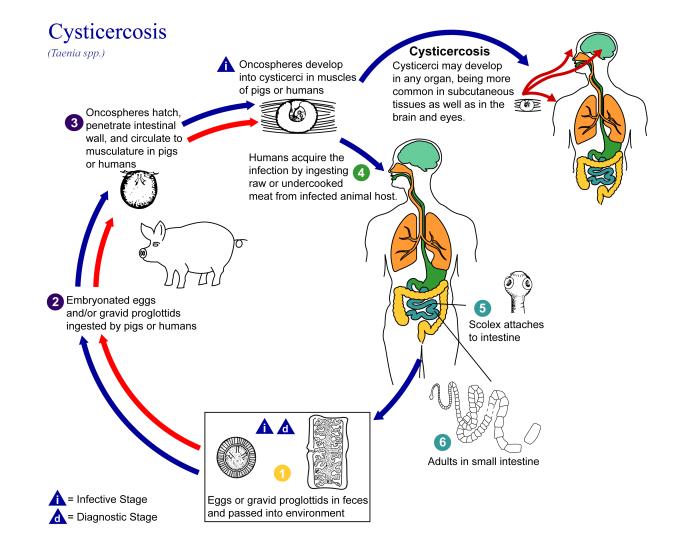Wikisage, the free encyclopedia of the second generation, is digital heritage
File:Cysticercosis by Taenia solium PHIL 3387 lores.jpg
Cysticercosis_by_Taenia_solium_PHIL_3387_lores.jpg (700 × 533 pixels, file size: 57 KB, MIME type: image/jpeg)
Summary
Cysticercosis
[Taenia solium] [Taenia spp.]
Causal Agent: The cestode (tapeworm) Taenia solium (pork tapeworm) is the main cause of human cysticercosis. In addition, the larval stage of other Taenia species (e.g., multiceps, serialis, brauni, taeniaeformis, crassiceps) can infect humans in various sites of localization including the brain, subcutaneous tissue, eye, or liver.
Life cycle of T. solium with resulting cysticercosis
Cysticercosis is an infection of both humans and pigs with the larval stages of the parasitic cestode, Taenia solium. This infection is caused by ingestion of eggs shed in the feces of a human tapeworm carrier . Pigs and humans become infected by ingesting eggs or gravid proglottids . Humans are infected either by ingestion of food contaminated with feces, or by autoinfection. In the latter case, a human infected with adult T. solium can ingest eggs produced by that tapeworm, either through fecal contamination or, possibly, from proglottids carried into the stomach by reverse peristalsis. Once eggs are ingested, oncospheres hatch in the intestine , invade the intestinal wall, and migrate to striated muscles, as well as the brain, liver, and other tissues, where they develop into cysticerci. In humans, cysts can cause serious sequellae if they localize in the brain, resulting in neurocysticercosis. The parasite life cycle is completed, resulting in human tapeworm infection, when humans ingest undercooked pork containing cysticerci . Cysts evaginate and attach to the small intestine by their scolex . Adult tapeworms develop, (up to 2 to 7 m in length and produce less than 1000 proglottids, each with approximately 50,000 eggs) and reside in the small intestine for years .
Geographic Distribution:
Taenia solium is found worldwide. Because pigs are intermediate hosts of the parasite, completion of the life cycle occurs in regions where humans live in close contact with pigs and eat undercooked pork. Taeniasis and cysticercosis are very rare in Muslim countries. It is important to note that human cysticercosis is acquired by ingesting T. solium eggs shed in the feces of a human T. solium tapeworm carrier, and thus can occur in populations that neither eat pork nor share environments with pigs
File history
Click on a date/time to view the file as it appeared at that time.
| Date/Time | Thumbnail | Dimensions | User | Comment | |
|---|---|---|---|---|---|
| current | 00:05, 27 February 2019 |  | 700 × 533 (57 KB) | Penarc (talk | contribs) | Cysticercosis [Taenia solium] [Taenia spp.] Causal Agent: The cestode (tapeworm) Taenia solium (pork tapeworm) is the main cause of human cysticercosis. In addition, the larval stage of other Taenia species (e.g., multiceps, serialis, brauni, taeniaef... |
You cannot overwrite this file.
File usage
The following page uses this file:
